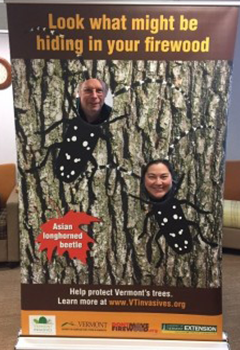Mar 5, 2018

I took the Foundations of Dialogue Education course with Global Learning Partners (GLP) in October 2017. The most powerful take-away for me was to think about what the learners will be doing with the content rather than what I will be saying or presenting.
Perhaps it is my love of theater and dramatic arts, but I can easily spend hours practicing what I will say for an upcoming presentation. I make my PowerPoint slides colorful, fun, use a lot of pictures, and work hard to keep the energy up. I work as the Forest Pest Education Coordinator with University of Vermont (UVM) Extension and the Vermont Urban and Community Forestry program. In a nutshell, I teach people about invasive forest insects such as the emerald ash borer and Asian long-horned beetle. I enjoy working with youth because I can make my workshops and presentations interactive. When it comes to adults, I feel like everyone is expected to sit in rows of uncomfortable chairs and listen to me “wa, wa, wa” at the front of the room. However, for me as a learner I can’t sit for long and my mind starts to turn to mush after about a half an hour of listening to someone talk.
Using the learning-centered 4A Model (Anchor-Add-Apply-Away) for developing a learning event has been incredibly helpful for transforming these adult workshops (I’ve stopped calling them presentations!) into intentional, dialogue-based, learning events. The results have been extremely positive.
Last month, I decided to take it one step further. We had a big meeting coming up with all our partners in Vermont that help support my work as Forest Pest Education Coordinator. Historically, this meeting has not been exciting. I literally read off the annual report I’d submitted for the grant that supports my position. We usually have one person who “leads” the meeting and there has been some discussion.
This time I suggested to my supervisor that I facilitate the meeting and incorporate some of what I learned during the GLP course I had taken. I took the topics that I was planning to “cover” and turned each one into a learning task or a “share out.” For example, I have hired a company to make a whiteboard animation video that covers the importance of not moving firewood – invasive insects can travel in firewood, so we ask that you buy it where you burn it.) I wanted to get input from the partners at the meeting before talking to the company about the video content. So, in pairs, I asked the group to “create a visual representation on chart paper of what you would like to see in a one-minute video on the importance of buying local firewood.” I was surprised at how well it worked! The pairs were talking, laughing, and drawing on their paper. The ideas they shared were incredibly useful for me and I’ve incorporated their thoughts into the first draft of the whiteboard video’s script.
Everyone at the meeting had an agenda in front of them that listed each learning task and used learner-centered language. Here are some excerpts:
From our coming together exercise:
Today is the darkest day of the year and a time for reflection. These short, cold days can stir up a lot of unease. Take a moment to consider what is sustaining you in your work right now and what is draining you.
From a section on outreach at private campgrounds in Vermont:
Listen to a brief review on private campground outreach from 2017. Take a look at the map example from last summer’s work and the written Best Management Practices. What kind of outreach to private campgrounds will lead us to the change in behavior we are hoping for?
Having the language written right there on the agenda not only helps the learning experience at the meeting, but I also figured it would be a clever way of sharing a more engaging way of meeting and learning with my colleagues. Here they can see how it is done and the simple ways they might change some of the language and structure of their meetings and workshops. Sharing what I learned is really important to me. I have absolutely enjoyed applying the principles of a learning-centered approach to my work, but I’d love to see others try it too.
The next morning after the meeting, I received an email from one of the participants. She wrote, “Just wanted to say how refreshing yesterday’s meeting was. You managed to cover a lot of ground in an hour and a half, and engage a normally reticent group.” I was smiling from ear-to-ear! That was exactly the kind of feedback I was hoping to hear.
What do you do in your meetings to help engage everyone?
*****
Meredith Whitney (Meredith.Whitney@uvm.edu) is the Forest Pest Education Coordinator with UVM Extension. She lives in Moretown, Vermont where she enjoys going for long walks and dreams of having a goat farm.
PHOTO: At the end of the meeting, everyone got their photo taken with an interactive banner that was designed last year for forest pest outreach. Look at those happy Asian long-horned beetles!



